Our Odd Quest Warrior deck list guide will teach you the ins-and-outs of this deck and how it fares in Rastakhan’s Rumble expansion! Our guide features mulligan, play, and card replacement strategies!
Introduction to Odd Quest Warrior
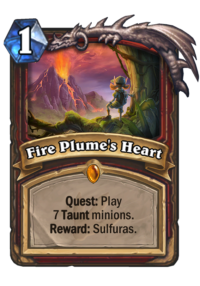
Odd Quest Warrior, just like any other Quest deck, originates from the Journey to Un’Goro. It was one of the first viable Quest decks back in that expansion (first as a non-Odd version, obviously), but soon it got pushed out of the meta by more powerful options. However, in the Year of the Raven, we’ve seen a resurgence of many Quest decks – some of them got new tools, other got stronger because of the meta change, and Quest Warrior is something in between.
The deck’s main game plan is to play defensively throughout the early and mid game, playing Taunt after Taunt to finish the Quest. Quest’s reward is a 4/2 weapon, which turns your Hero Power into “Deal 8 damage to a random enemy” – so at the cost of 2 mana per turn, you basically become a Ragnaros the Firelord for the rest of the game. While you lose your defensive Hero Power, being able to deal 8 damage every turn is a massive win condition – hitting your opponent puts him on a quick clock, while clearing minions is a big value win. Meanwhile, you can still drop more and more Taunts to keep yourself safe.
Over the course of this Standard year, we’ve seen both regular Quest Warrior and the Odd version taking blows. In Boomsday Project, the regular version turned out to be better. In Rastakhan’s Rumble, it’s the Odd version again. Odd version’s advantage is obvious – a much better Hero Power. The difference between +2 and +4 Armor per use is massive, especially in Aggro matchups (but also in general, as it makes using cards like Shield Slam and Reckless Flurry much easier). On the other hand, regular version has access to some strong cards, such as Execute and Blood Razor, which are also useful in general. However, since Odd version is the one being played right now, it’s the one we’ve picked for this updated guide.
Rastakhan’s Rumble Quest Warrior Deck List
Quest Warrior Mulligan Strategy & Guide
Vs Fast Decks
Important: You do not always want to keep Fire Plume's Heart against Aggro! Keeping your Quest no matter what is a common mistake – you often want to mulligan it away. A good example would be Odd Paladin – Quest is absolutely pointless in that matchup. Even if you finish it in time, the flood of tokens will make your new Hero Power much worse than the +4 Armor one. Odd Rogue is another example – it’s a matchup which you win by outlasting them, and +4 Armor Hero Power is much better for that. If they don’t get a good Myra’s Unstable Element, you win once they run out of resources. Of course, 8 damage Hero Power might come handy sometimes, but you will have a higher win rate by getting an extra card in mulligan instead.
Higher Priority (keep every time):
- Town Crier – Great 1-drop, 1/2 that draws a card is absolutely amazing. It’s the main reason why you play Rush minions.
- Shield Slam – Given that Armor won’t be a problem, having a way to kill anything for 1 mana is great. Can stop snowball minions like Hench-Clan Thug or Vicious Fledgling for taking over the game.
- Reckless Flurry – Similar to Shield Slam, but even better, because it’s AoE. Great way to clear early and mid game Aggro boards.
- Tar Creeper – Solid anti-Aggro option, your best Turn 3 play most of the time. It might buy you a lot of time, because not only it will tank 5 damage, but you opponent will most likely have to sacrifice some minions when trading, which slows him down.
- Dyn-o-matic – 5 damage spread among many targets is often your best Turn 5 play. Works well against both multiple small minions and a single mid-range minion. Even if you don’t kill everything, you should deal with some small minion and deal some damage to other stuff on top of that + it’s a 3/4 body on the board.
Lower Priority (keep only if certain conditions are met):
- Fire Plume's Heart – If you face slower Aggro or Midrange decks, such as Even Paladin or Secret Hunter, you actually do want to keep your Quest. Those decks pack quite a lot of value, so Taunts and removals alone might not be enough to win.
- Gluttonous Ooze – Against weapon decks. Works best vs Odd Rogue.
- Brawl – Against board flood decks, such as Odd Paladin or Zoo Warlock. While Flurry is just better, there’s no guarantee that you will draw it, and you absolutely need to have some sort of board clear going into the mid game.
- Supercollider – With a good early game hand (e.g. with another removal, some T3 play etc.) – the card is amazing, but if you have a very slow start, you can’t afford to poke minions with it.
Vs Slow Decks
Higher Priority (keep every time):
- Fire Plume's Heart – Against slow decks, Quest is your main win condition, so it’s an auto-keep.
- Shield Slam – You still want your single target removals in basically every matchup. No matter if you’re the one playing for tempo or playing defensively, you will find it useful.
- Town Crier – Given that it cycles itself while drawing a card that will bring you closer to finishing the Quest… there’s no reason to not keep it.
- Stonehill Defender – You want to finish your Quest as fast as possible, and Stonehill is two Taunts in one (or even more if you roll another Stonehill).
- Supercollider – It’s an amazing mid game board control tool in slower matchups. They rarely flood the board with small minions, often having only a few, but similarly statted minions up. You can get 2 for 1 with the first hit alone, and then even stop them from developing if they can’t destroy it.
Lower Priority (keep only if certain conditions are met):
- Gluttonous Ooze – Against weapon decks, including Warlock – if you suspect that you might face Cube/Control with Skull of the Man'ari (it’s a meta call mostly, but I would keep it given that Cube is the most popular Warlock archetype at the time I’m writing this).
- Reckless Flurry – Against decks that can put a solid board in the mid game. It’s a great keep vs Even or Cube Warlock, but not against Odd Warrior.
Odd Quest Warrior Play Strategy
Vs Fast Decks
If you read the mulligan section, you will understand that Quest is not your win condition in majority of the fast matchups. You would lose MUCH more games by starting with one card less (so you reduce your chance to draw a removal or the right Taunt early) than you would win by finishing the Quest and shooting them with 8 damage Hero Power.
Against Aggro, you play like a normal Control deck – you control the board and try to survive. The longer the game goes, the higher your chance to win is – you have access to bigger Taunts, more AoE etc. Early and mid game is most important, which is another reason why you don’t need your Quest.
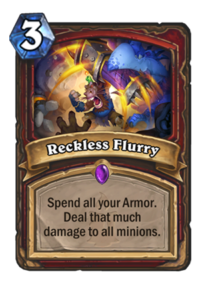
The deck runs some AoE removal, but not enough for you to waste – you need to use them carefully. Your two main AoE options are Reckless Flurry and Brawl. Flurry is by far the best card in your deck vs Aggro – it’s very easy to stack Armor, meaning that it’s usually a full board clear for just 3 mana. Even if they shave off your Armor with minions, on Turn 5 you can still Hero Power + Flurry for 4 AoE damage, which is usually enough to clear their mid game board (unless buffed by something like Fungalmancer). Getting rid of all your Armor vs Aggro might seem like a bad idea, but it really isn’t. If you use 8 Armor to remove 8 damage from the board, you didn’t actually lose any Armor – your opponent would swing with all his minions and you would be at the same health total, but with lots of minions still staring at your face.
Your second AoE removal is Brawl, one of the Classic Warrior staples. While Brawl does not require Armor to work, it has one huge downside – it will always leave a single minion on the board. If you have something on the board and you high-roll, then that’s great, but most of the time you will play it with no board on your side, and definitely not as much of a board as your opponent, which means that the chances are that you will still face a single minion after playing it. If some small token or a 1-drop wins, it’s not a big deal, but if your opponent has 3 minions and one of them is big, there’s a 1/3 chance that your Brawl will basically fail. That’s something you need to consider when playing it.
In general, try to play Brawl when you’re in a better situation, when you can afford to take a low roll. It’s also good against board in which your opponent has only small-ish minions, so no matter which one wins, it’s still good for you. Reckless Flurry is safer, but also has a big downside – if your opponent gets rid of your Armor every turn, you can only AoE for 4. Sometimes you can fix that with Shield Block (but SB + Hero Power + Flurry costs 8 mana, which is a lot), but it’s something you need to take into account. For example, if you play against a deck which constantly puts pressure on your Armor and you have an opportunity to kill some bigger minions with Flurry because you’ve managed to save some Armor, you might want to take that opportunity and do it.
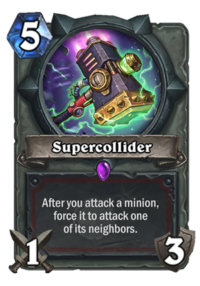
There are also two “semi-AoE” cards – Dyn-o-matic and Supercollider. Those are usually a great follow-up to AoE – once you clear the board and opponent starts re-developing, but doesn’t put enough minions on the board yet. 5-drop Mech works very well against token-heavy decks like Odd Paladin, where each hit kills a small minion. Supercollider is great against decks that go a bit more tall, such as Odd Rogue – you can usually clear 2 minions immediately and then possibly threaten clearing even more over the next few turns.
Keep in mind that most of the Aggro decks have multiple ways to refill their hand and/or the board – using your only AoE when the board isn’t very threatening might not be the best idea, because your opponent might just drop more stuff over the next turn or two and you might no longer have a way to do it. One big advantage of upgraded Hero Power is that you can take some beating and bait your opponent to play more. There’s no reason to AoE a board with 5 damage in total, because technically you’re only taking 1 damage per turn (since you gain 4), and the longer the game goes, the better it is for you – so you don’t need to do anything, your opponent has to play more stuff, and THEN you can AoE.
In the mid game, you generally want to first clear the board and then play your Taunt cards. Taunts are more useful when your opponent can’t clear them – they will just stop minions from attacking, gaining you a lot of life. Dropping a Taunt which your opponent can clear quite easily is counter-productive. Yes, you save some life, but you didn’t really accomplish that much. Of course, if you’re desperate and you need to survive, you still do it, but if you have a choice, removals should come before Taunts.

One common mistake is keeping Phantom Militia until you can play it 2-3 times. You absolutely want to do it vs slower decks, but not necessarily against Aggro. While it’s only a 3 mana 2/4 Taunt on Turn 3, don’t hesitate to drop it if you have no other play. Yes, it’s not optimal, but it’s still much better than skipping your turn. Tempo is important – if you can clear some minions and stop some damage early, you might be able to save your AoE for much longer, which is only beneficial.
So, basically, that is your plan. Keep clearing the board and playing the Taunts. If you draw the Quest you’ve mulliganed away, there is no harm in playing it, you might be able to finish it sometimes. Once you finish it, however, you don’t always want to play it. 4 Armor Hero Power is sometimes better than 8 damage Hero Power. It’s true when you’re at low health, or when you face a deck that wants to burn you down. You can still use it as a finisher – weapon hit + Hero Power is 12 damage + whatever you have on the board can add up to ~20 damage or something. Even if your opponent has minions on the board, you still have 5 mana to squeeze in e.g. a Reckless Flurry or Brawl.
Vs Slow Decks
Your matchups vs slow decks are quite different than those vs fast decks. You could say that at the point where most of the Aggro matchups finish, the REAL game against slow decks start.
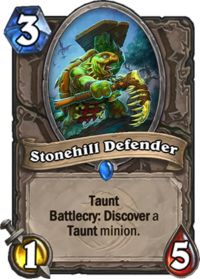
Your #1 priority against slow decks if finishing your Quests. The Taunt minions are generally not very efficient – you don’t put a lot of pressure with them, they should be relatively easy to clear and they don’t give you much value. However, once you finish the Quest, your Hero Power will make up for that. It’s important to try to drop a Taunt minion every turn you can. Ideally you’d want to finish your Quest around Turn 8-9 (and then play it next turn). Both Stonehill Defender and Phantom Militia are super helpful when it comes to that. When it comes to Stonehill, don’t be too greedy – since your goal is to finish a Quest as quickly as possible, it’s often much better to keep e.g. a Goldshire Footman than for example a Giant Mastodon. Funnily enough, the best pick is often another Stonehill – you get another +1 on the Quest and can potentially reroll if your other options were bad. If you already have means to finish the Quest in your hand, THEN you might pick some high value card, especially Even-costed, so they can be used better to fill your curve. E.g. The Lich King or Primordial Drake are great, not only because they’re strong cards in general, but they give you a Turn 8 play, where normally you’d probably play a 7-drop or maybe even a smaller minion instead. Phantom Militia, on the other hand, is a good Turn 6 or Turn 9 play – you don’t have any other 6 (obviously) or 9 mana Taunts in this deck anyway, so filling your turn with two/three of them should bring you closer to finishing the Quest, or even finish it.
Your AoE removals might not be that useful in Control Matchups, at least not until after you’ve finished your Quest. You might stop playing Taunts and e.g. drop a Brawl or Reckless Flurry in case your opponent develops a solid board, but against most of the decks Taunts alone are enough. AoE clears still come handy against slow decks that want to put minion pressure – such as Even Warlock, where a well-timed Brawl can win you the game. However, I’d say that single target removals are more key against slow decks. You have only two, guaranteed single target removals, so it’s important to understand how many big threats they run and which take the highest priority. For example, if you have only a single Shield Slam in your hand and Even Warlock drops a 6/5, you might want to try to remove it another way, or stall the game with Taunts – save it for The Lich King or let’s say a 4/10 Drake that you might not be able to remove other way.
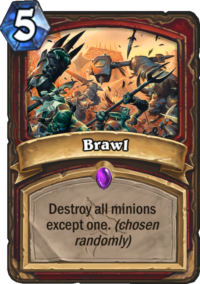
After you finish your Quest, you want to equip the weapon as quickly as possible and start shooting the Hero Power every single turn. I mean it, unless you need full mana or else you would die, shoot it every single turn. However, don’t do that at the beginning of each turn – you want to set up for it first. For example, if you opponent drops a bunch of small minions, you want to AoE them down first. A natural reaction to you finishing the Quest will be playing multiple minions, which you can punish with Brawl.
With your new Hero Power, you no longer want to play the control role. You want to be the beatdown. As much as hitting the face instead of a minion might seem like a low-roll sometimes, you actually WANT the Hero Power to hit your opponent most of the time (unless the choice is between a big minion such as Lich King and face – but hitting face instead of a smaller/midrange minion is usually great). Assuming no healing, all you need is three times 8 damage into their Hero and you can finish the rest with your weapon.
Since you will have 8 more mana to work with every turn, you want to either clear the board (in case of board flood) or drop some Taunts. Taunts should keep you relatively safe for a while, as long as you don’t completely lose the board control. The ideal scenario is putting lots of pressure on your opponent with Hero Power and then dropping some minions. Now he has to both heal himself up, play some minions so your Hero Power won’t hit him again AND deal with your board. Such a situation is often a way to close out the game in such matchups, simply because your opponent won’t be able to do all of that at the same time.
Blackwald Pixie is pretty interesting once you finish the Quest, as it lets you play your Hero Power Twice. You can even do that one the same turn you finish your Quest if you’re at 10 mana. And so, equipping the reward + Hero Power + Pixie + Hero Power is 20 damage in total, assuming the weapon goes face. That’s a nice way to surprise burst your opponent when he’s not expecting that much damage. But the combo with Pixie is great basically at any time (after you have finished the Quest, Pixie becomes a 5 mana 3/4 with “Battlecry: Deal 8 damage to a random enemy”).
Odd Quest Warrior Card Substitutions
Just like Odd Warrior, the Quest version is also quite expensive deck, usually in the 10-13k Dust range. While it is possible to make it a bit cheaper, some of the cards are simply impossible to replace.
- Fire Plume's Heart – A QUEST deck doesn’t really make sense without a Quest, does it?
- Zilliax – The card is just very good. Even the decks that don’t synergize with it at all play it, and for you it also procs the Quest + you can draw it from Town Crier. If you don’t have it, I would really craft it (it’s the best Legendary from Boomsday Project), but technically you can play the deck without it.
- Baku the Mooneater – You can’t play an Odd deck without Baku, so it’s a must-have.
- Shield Slam – Since you can’t run Execute and you would need a Dragon package to play Smolderthorn Lancer (so you would need to remake the deck completely), Shield Slams are your only big single target removals. Which means that they are absolutely necessary.
- Town Crier – Amazing cards, any deck that runs Rush minions wants to play them. You could technically do without them, but it would make your Zilliax and Amani War Bears much less powerful.
- Gluttonous Ooze – Weapon destruction, while not necessary in the current meta, is always a nice tech. Odd deck doesn’t have a luxury of replacing this card with Acidic Swamp Ooze, but you can still use one of the 5 mana options or play the deck without it.
- Reckless Flurry & Brawl – Two of your Epic board clears. There are no real, direct replacements for them. I’d say that you need AT LEAST 3 out of 4 for the deck to be successful, but a full playset is obviously optimal.
- Supercollider – Surprisingly, it became one of the strongest Boomsday Project cards, especially in Odd decks, which can’t run Blood Razor. While not absolutely necessary, getting rid of it (especially both copies, dropping one still might be fine) would lower the deck’s win rate by quite a lot.
And here is the list of potential replacements:
- Dragon Package – If you’re missing quite a lot of cards, you can consider adding a Dragon package instead, but it also has some Epic cards in it. It consists of Smolderthorn Lancer, Dragonmaw Scorcher, Emberscale Drake and Crowd Roaster. It can be used to fill the gaps quite nicely, but you need to add ALL of those cards, otherwise it doesn’t make much sense.
- Corrosive Sludge or Harrison Jones – Replacements for Gluttonous Ooze if you still want to run weapon destruction. If you face a lot of weapon decks, you might even consider running two weapon destruction cards in total, but it’s most likely an overkill.
- Acolyte of Pain – Solid generic replacement. Card draw is always welcome, the 1/3 body can actually contest some 1-drops, and it can also be combo’d with Dyn-o-matic to draw 3. Not necessarily the best in this deck, but works alright.
- Witchwood Grizzly – If you’re missing some Taunts, you can consider running Witchwood Grizzly instead. It’s mostly an anti-Aggro option – the card is pretty bad (commonly a 3/4 or a 3/5) against Control, but it’s often a 3/10 versus decks that run out of cards quickly. If you add them ON TOP of Rush package, you can also consider playing Oondasta. More cards to draw from Town Crier (so they basically never miss at this point), and Oondasta can pull 3/12 Grizzlies or 5/7 Bears with Rush.
- Mind Control Tech – Another “generic” replacement, especially if you’re missing some AoE card. MCT high rolls can win the game sometimes (e.g. against Odd Paladin with 3x 1/1 and a 7/7 Frostwolf Warlord – stealing Warlord is often game over for Paladin in that scenario), and it’s a good way to “save” an AoE clear. Dropping MCT instead is often nearly as good, even if you steal something small, you still have two bodies to trade with.

You are just writing words without thinking. How are we supposed to know what type of palidan we are up against when mulliganing?
Stuck in rank 18, no way to deal with Maly Rogue, Mechathun Priest, Hand Mage, Boom Hunter. Rank 18 is full of this cancer decks, super fun.
Dust cost 7280. It´s a good solid control deck. I have a big problem with Bomb Hunter, OTK Priest, Maly Rogue and Face Rogue in this meta. No problems with Cubelock, Odd Paladin, Odd Rogue, Even Paladin. 50/50 is with Spell Hunter, Maly Druid, Toggwagle Druid, Mech Warrior…